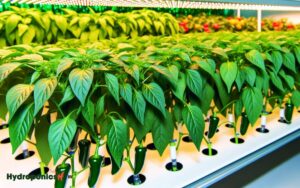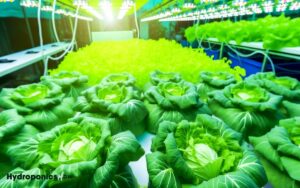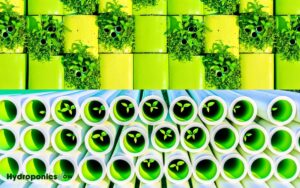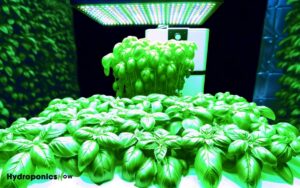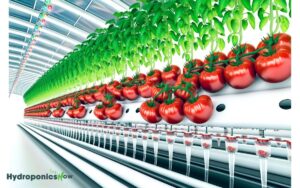What Type of Containers Are Acceptable for Deep Water Hydroponics?
Selecting the appropriate container for deep water hydroponics is crucial for an effective system. Suitable options include plastic buckets, net pots, food-grade containers, mason jars, and specialized hydroponic containers.
Storage totes and aquaponics tanks are also viable. Verify containers have features like airtight seals, light-blocking properties, and non-reactive surfaces.
Containers should be cleaned, sterilized, and inspected prior to use. Recycled materials can be adapted but must meet these criteria.
Specialized containers with integrated aeration systems and water level indicators offer enhanced management. For further details on optimizing container choices, continue exploring.
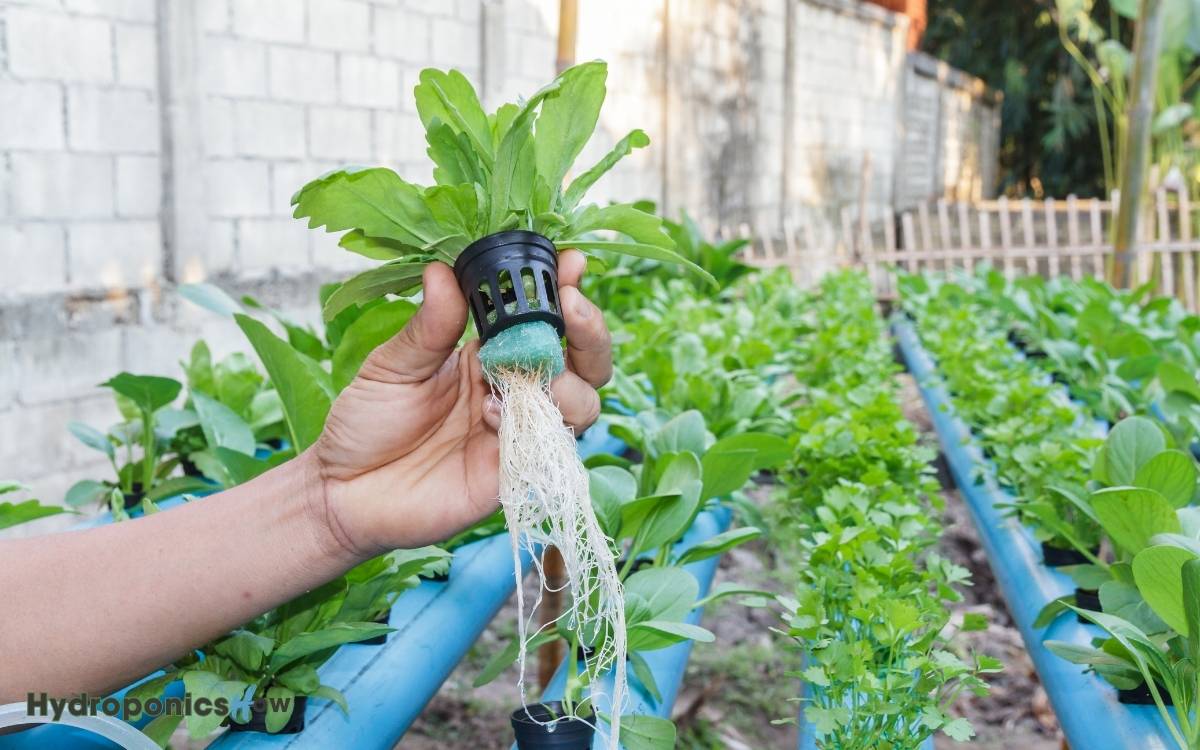
Key Takeaways
Plastic Buckets
Furthermore, plastic buckets are a commonly utilized container in deep water hydroponics due to their durability, availability, and cost-effectiveness.
These containers, typically made from high-density polyethylene (HDPE), offer excellent resistance to both physical wear and chemical corrosion, making them suitable for long-term use.
The availability of various sizes allows for flexibility in system design, accommodating different plant types and growth stages.
Additionally, their cost-effectiveness is particularly beneficial for large-scale operations, where budget constraints are critical. The opaque nature of most plastic buckets also helps to inhibit algae growth by blocking light penetration.
Additionally, they are easily modified with drill holes for air tubing and other necessary components, enhancing their functional adaptability in hydroponic setups.
Net Pots
In conjunction with plastic buckets, net pots serve as essential components in deep water hydroponics systems, offering structural support and ideal root aeration for plants.
These pots, typically constructed from durable plastic, feature a mesh design that facilitates ideal nutrient uptake and oxygen exchange for plant roots.
The open structure of net pots allows unrestricted root growth, enhancing overall plant health and vigor. Sizes vary to accommodate different plant species, and the pots can be easily inserted into pre-cut holes in the lid of the hydroponic bucket.
Food-Grade Containers
Food-grade containers are essential for deep water hydroponics due to their non-toxic materials, ensuring the safety and health of both plants and consumers.
These containers offer superior durability and longevity, withstanding the moist and nutrient-rich environment without degrading.
Utilizing food-grade containers mitigates risks of chemical leaching, which can compromise plant growth and food safety.
Safety and Health Benefits
Utilizing containers made from food-grade materials guarantees that harmful chemicals do not leach into the water, safeguarding both plant health and human consumption.
These materials are specifically designed to meet stringent regulatory standards, ensuring that they do not release toxic substances under various environmental conditions.
The use of food-grade containers in deep water hydroponics presents several significant health benefits:
- Non-Toxicity: Food-grade containers are manufactured to be free from harmful compounds like BPA and phthalates, thereby preventing chemical contamination.
- Purity: These containers maintain the purity of nutrient solutions, promoting excellent plant growth and higher yields.
- Compliance: Utilizing certified food-grade materials ensures adherence to health and safety regulations, offering peace of mind to both growers and consumers.
Durability and Longevity
Frequently lauded for their robustness, containers made from food-grade materials exhibit exceptional durability and longevity, making them an ideal choice for deep water hydroponics systems.
These containers are engineered to withstand extended exposure to water, nutrients, and root systems without degrading or leaching harmful substances.
The high-density polyethylene (HDPE) and polypropylene (PP) used in these containers resist cracking, UV radiation, and chemical corrosion, ensuring structural integrity over time.
Additionally, their non-reactive surfaces prevent microbial growth and biofilm formation, which can compromise plant health. The longevity of food-grade containers reduces the frequency of replacements, offering economic and environmental benefits.
Consequently, investing in such containers assures a reliable, efficient, and safe hydroponic setup for long-term cultivation.
DIY Containers
When constructing DIY containers for deep water hydroponics, selecting materials that guarantee structural integrity and non-toxicity is essential. This ensures the system is both durable and safe for plant growth.
Certain materials and methods are particularly advantageous for DIY projects:
- Food-grade plastic buckets: Make sure the plastic is labeled as food-safe to avoid leaching harmful chemicals into the water. Buckets should be sturdy enough to support water weight.
- PVC pipes and fittings: Use PVC pipes to create a support framework. Ensure they are also food-grade to maintain water quality and structural integrity.
- Liner materials: Utilize pond liners or other waterproof materials to line non-waterproof containers. These liners must be puncture-resistant and non-toxic to sustain a stable hydroponic environment.
These components facilitate effective and safe DIY hydroponic setups.
Storage Totes
When considering storage totes for deep water hydroponics, it is important to examine the material and durability to make sure they can withstand prolonged exposure to water and nutrients.
The size and capacity of the totes must be aligned with the specific requirements of the plant species being cultivated.
Additionally, the lid’s design and its lightproofing capabilities are essential to prevent algae growth and maintain the integrity of the hydroponic system.
Material and Durability
Selecting the appropriate material for storage totes in deep water hydroponics is essential to guarantee durability, chemical resistance, and structural integrity under constant exposure to water and nutrient solutions.
The following materials are recommended for their robust performance:
- High-Density Polyethylene (HDPE): Known for its excellent chemical resistance, HDPE is durable and can withstand the hydroponic environment without degrading.
- Polypropylene (PP): This material offers high tensile strength and resistance to a broad range of chemicals, making it suitable for long-term use.
- UV-Stabilized Plastics: These plastics are treated to resist degradation from ultraviolet light, ensuring longevity and preventing brittleness or cracking when exposed to light sources.
Proper selection of these materials will extend the lifespan and performance of storage totes in hydroponic systems.
Size and Capacity
In addition to material selection, determining the appropriate size and capacity of storage totes is crucial for optimizing the efficiency and functionality of deep water hydroponic systems.
Storage totes must be sufficiently large to accommodate the root systems of the plants being cultivated, which can vary greatly based on the species and growth stage.
Common capacities range from 5 to 50 gallons, with larger totes providing more stability, nutrient solution volume, and root space. However, increased size may also require stronger structural integrity to prevent bowing or cracking under the weight of the water.
Additionally, the dimensions of the tote should be compatible with the spatial constraints of the growing environment to secure ease of maintenance and accessibility.
Lid and Lightproofing
Securing storage totes with a sturdy, lightproof lid is crucial for preventing algae growth and maintaining ideal conditions for plant roots in deep water hydroponic systems.
Light exposure can encourage algae proliferation, which competes with plants for nutrients and oxygen. A well-fitted lid helps mitigate this risk by blocking light and providing a stable environment.
When selecting storage totes, consider:
- Material: Choose opaque materials like black or dark-colored plastic to enhance lightproofing.
- Fit: Ensure the lid fits snugly to prevent any light leakage and to maintain humidity levels.
- Durability: Opt for heavy-duty, UV-resistant lids to withstand environmental stress and prolong the system’s usability.
These factors collectively promote optimal growth conditions in hydroponic setups.
Mason Jars
Mason jars, with their robust glass construction and airtight seals, provide an ideal environment for deep water hydroponics due to their light-blocking properties and ease of nutrient solution monitoring.
Their transparent nature allows for precise observation of root health and nutrient levels, which is crucial for maintaining peak growing conditions.
The glass material is non-reactive, ensuring that no harmful chemicals leach into the nutrient solution. Additionally, the airtight seal prevents contamination, maintaining a stable and controlled environment.
However, it is essential to shield the jar from excess light to prevent algae growth. This can be achieved by wrapping the jar in opaque materials or using light-blocking coatings, ensuring that the hydroponic system remains efficient and effective.
Recycled Containers
Utilizing recycled containers in deep water hydroponics offers significant environmental impact benefits by reducing waste and promoting sustainability.
Common recycled materials such as plastic bottles, food-grade buckets, and old storage bins can be effectively repurposed for hydroponic systems.
Proper preparation of these containers, including thorough cleaning and ensuring they are free of contaminants, is essential to maintain plant health and system efficiency.
Environmental Impact Benefits
Recycled containers offer significant environmental impact benefits by reducing waste and minimizing the carbon footprint associated with the production and disposal of traditional hydroponic systems.
By repurposing materials, hydroponic practitioners can contribute to a more sustainable agricultural practice.
Key benefits include:
- Waste Reduction: Utilizing recycled containers diverts materials from landfills, decreasing environmental pollution and conserving resources.
- Energy Savings: The energy required to produce new containers is substantially higher than that needed to repurpose existing ones, leading to lower overall energy consumption.
- Carbon Footprint Minimization: By reducing the demand for new plastic or other synthetic materials, recycling helps decrease greenhouse gas emissions associated with manufacturing processes.
These advantages underscore the environmental sustainability of recycled containers in deep water hydroponics.
Common Recycled Materials
Among the most commonly repurposed materials for deep water hydroponic containers are food-grade plastic barrels, repurposed fish tanks, and large plastic storage bins, each offering unique properties that enhance their suitability for hydroponic systems.
Food-grade plastic barrels are durable and resistant to chemical leaching, ensuring a safe environment for plants.
Repurposed fish tanks provide excellent visibility, allowing for easy monitoring of root health and water conditions.
Large plastic storage bins are inexpensive and readily available, making them an economical choice for beginners.
| Material | Benefits |
|---|---|
| Food-Grade Plastic Barrels | Durable, chemical-resistant, safe for plants |
| Repurposed Fish Tanks | Excellent visibility, easy monitoring of root health |
| Large Plastic Storage Bins | Inexpensive, readily available, economical for beginners |
Each of these recycled materials contributes to sustainable and efficient hydroponic gardening.
Preparing Containers Properly
Proper preparation of recycled containers is crucial to guaranteeing a successful deep water hydroponics system. Thorough cleaning and sterilization of these containers prevent contamination and promote healthy plant growth.
Follow these steps meticulously:
- Cleaning: Rinse containers with water to remove residues. Use a mild detergent and scrub the interiors. Avoid harsh chemicals that may leave harmful residues.
- Sterilization: Soak the cleaned containers in a solution of one part bleach to nine parts water for at least 10 minutes. Rinse thoroughly with clean water to remove any bleach traces.
- Inspection: Examine containers for any damage or weak points. Ensure they are structurally sound to support the weight of water and plants.
Aquaponics Tanks
Aquaponics tanks, which serve as the foundational reservoirs for combining aquaculture and hydroponics, must be designed with specific considerations for material durability, water quality management, and integration with auxiliary systems.
These tanks are typically constructed from food-grade plastics, fiberglass, or stainless steel to guarantee longevity and prevent contaminants from leaching into the water.
Effective water quality management necessitates the use of biofilters and aeration systems to maintain ideal nutrient levels and oxygenation.
Additionally, tanks must be compatible with auxiliary systems such as water pumps, heaters, and monitoring sensors to maintain stable environmental conditions.
Proper tank design also includes considerations for ease of cleaning and maintenance to support the health and productivity of both fish and plants.
Specialized Hydroponic Containers
Specialized hydroponic containers, specifically engineered to optimize water circulation and root aeration, play an important role in the efficiency and productivity of deep water culture systems. These containers are designed with features that enhance the growth environment for plants. Their unique construction helps prevent root rot by ensuring proper oxygenation while maintaining consistent nutrient availability. Additionally, these containers can be integrated into a vertical hydroponic system at home, allowing growers to maximize space and cultivate more plants in a smaller area. This makes them an excellent choice for both beginners and experienced hydroponic gardeners seeking efficient and high-yield growing solutions.
Key characteristics include:
- Integrated Aeration Systems: Containers often come with built-in aeration mechanisms to guarantee consistent oxygen supply to the roots, essential for preventing root rot and promoting vigorous growth.
- Durable Construction: Made from high-quality, non-reactive materials, these containers resist corrosion and degradation, ensuring longevity and maintaining a stable growing environment.
- Water Level Indicators: Many specialized containers include water level markers or automated sensors, facilitating precise monitoring and adjustment of nutrient solution levels to meet plant needs effectively.
Light-Proof Containers
Light-proof containers are essential in deep water hydroponics to prevent algae growth and maintain nutrient solution quality by blocking out all light.
Algae, a photosynthetic organism, proliferates in environments exposed to light, leading to nutrient depletion and competition for oxygen, which compromises plant health.
To mitigate these risks, containers should be constructed from opaque materials such as black or dark-colored polyethylene or polypropylene. Additionally, UV-resistant coatings can be applied to containers to enhance their light-blocking capabilities and durability.
Ensuring complete light exclusion, including at seams and lids, is vital.
Employing light-proof containers not only optimizes plant growth but also minimizes maintenance requirements by reducing the need for frequent cleaning and nutrient solution replacement.
Conclusion
In essence, selecting appropriate containers for deep water hydroponics is vital to system efficacy and plant health.
Options include plastic buckets, net pots, food-grade containers, DIY containers, storage totes, recycled containers, aquaponics tanks, specialized hydroponic containers, and light-proof containers.
Each type offers distinct advantages, contingent upon specific requirements and constraints. Ensuring the chosen container meets criteria for durability, inertness, and light exclusion is akin to laying a solid foundation for a thriving hydroponic ecosystem.

